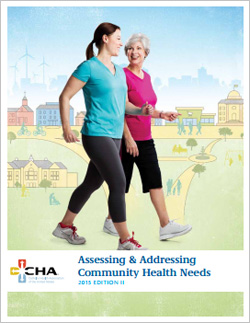BY: INDU SPUGNARDI
The Catholic Health Association has released three resources to help tax-exempt hospitals fulfill their community benefit mission and comply with legal requirements. The publications incorporate the most recent IRS 990 Schedule H instructions and the final rules implementing Patient Protection and Affordable Care Act (ACA) provisions for tax-exempt hospitals.
BACKGROUND
Over the last seven years, tax-exempt hospitals have seen new federal requirements put into place to ensure that they are meeting their charitable obligations. In 2008, the Internal Revenue Service added Schedule H to the IRS Form 990 specifically for tax-exempt hospitals to report community benefit and other tax-exemption information. In 2010, the ACA added Section 501(r) to the Internal Revenue Code, which requires tax-exempt hospitals to conduct a community health needs assessment (CHNA) at least once every three years and to adopt an implementation strategy to meet needs identified in the assessment. Section 501(r) also requires tax-exempt hospitals to comply with new requirements around financial assistance and emergency care policies, amounts charged and billing and collection procedures.1
The impetus for these requirements was the increasing number of questions from communities, the media and policymakers as to whether tax-exempt hospitals were fulfilling their commitment to meet the pressing health needs of their communities, particularly in regard to the provision of financial assistance.2 Some asked if there was a difference between not-for-profit and for-profit hospitals.
The same question was asked more than 25 years ago, when health care also saw significant change. Competition for patients was growing, as was the need for hospitals to be more efficient in their operations, spurring local not-for-profit hospitals to join large health systems. Communities and policymakers feared not-for-profit hospitals' commitment to their community was taking second place to business concerns.
At this time, CHA published its first community benefit resource, the Social Accountability Budget, designed to help tax-exempt hospitals proactively budget for their community benefit efforts and to accurately report those efforts to their communities and other stakeholders.
UPDATED PUBLICATIONS
The Social Accountability Budget has since been replaced by the following CHA publications that have been revised in 2015 to incorporate leading practices and approaches in community benefit and to align with the final 501(r) regulations published in December 2014.3
 Assessing and Addressing Community Health Needs — This resource was published in 2010 as a draft discussion document to help tax-exempt hospitals meet ACA requirements in conducting community health needs assessments and developing implementation strategies. The resource is now available as a final document incorporating the final 501(r) regulations. It also includes new approaches and tools that hospitals can use to improve their CHNA and community benefit planning processes.
Assessing and Addressing Community Health Needs — This resource was published in 2010 as a draft discussion document to help tax-exempt hospitals meet ACA requirements in conducting community health needs assessments and developing implementation strategies. The resource is now available as a final document incorporating the final 501(r) regulations. It also includes new approaches and tools that hospitals can use to improve their CHNA and community benefit planning processes. Evaluating Your Community Benefit Impact — First published in 2008, this resource has been updated to help hospitals comply with regulations implementing 501(r) that require hospitals to include the anticipated impact of actions in their implementation strategy reports, as well as to document an evaluation of actions taken to address health needs since the last CHNA. The evaluation framework presented in this book is based on the Centers for Disease Control and Prevention's Framework for Program Evaluation, which is composed of six steps: 1) engage stakeholders; 2) describe the program; 3) focus the evaluation design; 4) gather credible evidence; 5) justify conclusions; 6) ensure use and share lessons learned. The resource includes a case study that shows readers how this public-health-based evaluation approach can be applied to community benefit programs.
Evaluating Your Community Benefit Impact — First published in 2008, this resource has been updated to help hospitals comply with regulations implementing 501(r) that require hospitals to include the anticipated impact of actions in their implementation strategy reports, as well as to document an evaluation of actions taken to address health needs since the last CHNA. The evaluation framework presented in this book is based on the Centers for Disease Control and Prevention's Framework for Program Evaluation, which is composed of six steps: 1) engage stakeholders; 2) describe the program; 3) focus the evaluation design; 4) gather credible evidence; 5) justify conclusions; 6) ensure use and share lessons learned. The resource includes a case study that shows readers how this public-health-based evaluation approach can be applied to community benefit programs. A Guide for Planning and Reporting Community Benefit — Updated from the 2012 edition, this resource lays out a comprehensive approach for planning, implementing, evaluating and reporting community benefit. It includes summarized information from CHA's assessment and evaluation guides, along with updated information on what counts as community benefit and accounting guidelines that help hospitals complete the IRS Form 990 Schedule H. The guide also describes how community benefit can be an important component of an organization's population health strategy.
A Guide for Planning and Reporting Community Benefit — Updated from the 2012 edition, this resource lays out a comprehensive approach for planning, implementing, evaluating and reporting community benefit. It includes summarized information from CHA's assessment and evaluation guides, along with updated information on what counts as community benefit and accounting guidelines that help hospitals complete the IRS Form 990 Schedule H. The guide also describes how community benefit can be an important component of an organization's population health strategy.
A common theme across all these resources is collaboration, particularly with local public health departments. The driving force behind the need to collaborate is the growing recognition that the most effective way to address the root causes of poor health is to improve social and environmental conditions (such as education, nutrition, housing, safety, air and water) in communities. These efforts require health care providers, public health departments and community stakeholders to work together.4 While addressing the root causes of poor health has long been a goal of public health, it is gaining greater acceptance as a strategic aim by health care organizations that must deliver better care at lower cost. That goal is easier to achieve if community stakeholders work together to keep communities healthy in the first place.5
Identifying and meeting the health needs of their communities, particularly the needs of the poor and vulnerable, has been a hallmark of Catholic health care since its beginning. While the ministry's mission to serve its communities has not changed, the health care landscape has, meaning the ways of providing community benefit must change as well. CHA's revised community benefit resources, along with its other educational offerings such as "Community Benefit 101," an annual in-person workshop, webinars, and online resources can help position Catholic health care and other not-for-profit health care organizations to meet the challenge.6
INDU SPUGNARDI is director, advocacy and resource development, the Catholic Health Association, Washington, D.C.
NOTES
- Internal Revenue Service, "New Requirements for 501(c)(3) Hospitals Under the Affordable Care Act" www.irs.gov/Charities-&-Non-Profits/Charitable-Organizations/New-Requirements-for-501%28c%29%283%29-Hospitals-Under-the-Affordable-Care-Act.
- John Carreyrou and Barbara Martinez, "Grassley Targets Nonprofit Hospitals on Charity Care," The Wall Street Journal, Dec. 18, 2008. Retrieved from www.wsj.com/articles/SB122957486551517519.
- "Additional Requirements for Charitable Hospitals; Community Health Needs Assessments for Charitable Hospitals; Requirement of a Section 4959 Excise Tax Return and Time for Filing the Return; Final Rule," Federal Register, 79 FR 78953. www.gpo.gov/fdsys/pkg/FR-2014-12-31/pdf/2014-30525.pdf.
- Robert Wood Johnson Foundation Commission to Build a Healthier America, Time to Act: Investing in the Health of Our Children and Communities (2014). www.rwjf.org/content/dam/farm/reports/reports/2014/rwjf409002.
- Institute for Healthcare Improvement, "IHI Triple Aim Initiative." www.ihi.org/engage/initiatives/tripleaim/pages/default.aspx.
- For more information, visit www.chausa.org/communitybenefit. To order CHA community benefit publications, please contact the CHA Service Center at (800) 230-7823 or [email protected].